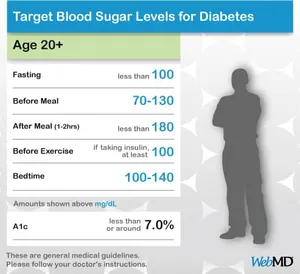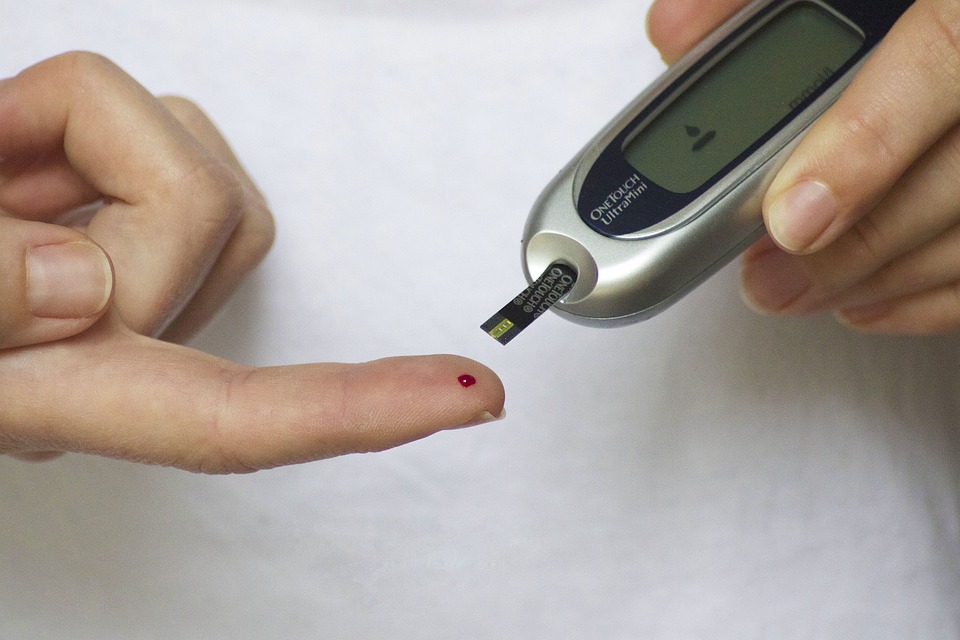Your body supplies your cells with energy using blood glucose (blood sugar) produced from dietary carbohydrates. Normally, the body regulates blood glucose levels so there’s always enough to fuel cells, but not so much that the bloodstream is overloaded with sugar.
For people with diabetes, this balance is thrown off due to problems with insulin. Insulin is a hormone produced by the pancreas that helps keep blood glucose levels stable. Blood sugar fluctuates throughout the day depending on what and when you eat, physical exertion, and other factors.
This is why monitoring glucose levels is a key aspect of managing all types of diabetes, particularly for those who take insulin. Using a glucometer at home allows you to measure it regularly.
What Are Blood Sugar Levels?
Your blood sugar levels, also known as blood glucose levels, are a measurement that show how much glucose you have in your blood. Glucose is a sugar that you get from food and drink.
Your blood sugar levels go up and down throughout the day and for people living with diabetes these changes are larger and happen more often than in people who don’t have diabetes.
Can I Check My Own Blood Sugar?
You can do blood sugar level check by doing a finger-prick test, or by using an electronic blood sugar monitor called a flash glucose monitor or CGM. You can do this several times a day – helping you keep an eye on your levels as you go about your life and help you work out what to eat and how much medication to take. Find out your ideal target range.
Not everyone with diabetes needs to check their levels like this. You’ll need to if you take certain diabetes medication. Always talk to your healthcare team if you’re not sure whether that’s you – they’ll give you advice on whether to check them yourself and how often.
And there’s also something called an HbA1c, which is a blood test to measure your average blood sugar level over the last three months. Everyone with diabetes is entitled to this check.
High blood sugar levels increase your risk of developing serious complications. However you manage your diabetes, stay in the know about your blood sugar levels.
What happens when your blood sugar levels are too low?
Low blood sugar is called hypoglycemia. If your blood sugar levels are too low, usually below 4 mmol/l, you may experience a hypo. Hypos need to be treated immediately, otherwise your blood sugar levels will drop further. If this happens, you may experience a severe hypo and need emergency treatment.
Symptoms of hypoglycemia are: shaking, sweating, dizziness, confusion, anxiety, irritability and hunger. You may experience all of these or only some of these. Low blood sugar can happen to people without diabetes.
There are many different symptoms of a hypo, so it’s important that you are aware of the signs in case your blood sugar level gets too low.
What happens when your blood sugar levels are too high?
High blood sugar is called hyperglycemia. If your blood sugar levels are slightly above your targets, there are usually no symptoms. But if your blood sugar levels become too high, you may experience some symptoms associated with a hyper.
The blood sugar level at which symptoms begin to appear is different for everyone, but the common symptoms include passing more urine than normal, being very thirsty, having headaches and feeling tired and lethargic.
Why Test Blood Sugar Levels?
If you take certain medication, like insulin or sulfonylureas, checking your blood sugars is a vital part of living with diabetes. It can help you work out when you need to take more medication, when you need to eat something or for when you want to get up and move around more.
Routine checks can help you know when you might be starting to go too low (called a hypo) or too high (called a hyper). It’s a way of getting to know your body and how it works. It can help you and your healthcare team spot patterns too. Do you write your results down? You might find that helpful.
But importantly, it will help you stay healthy and prevent serious diabetes complications now and in the future. By complications, we mean serious problems in places like your feet and your eyes. This happens because too much sugar in the blood damages your blood vessels, making it harder for blood to flow around your body. This can lead to very serious problems like sight loss and needing an amputation.
Ideal Blood Glucose Levels
Your ideal level of blood glucose depends on a number of factors, including:
- Your age
- How long you have had diabetes
- Medications you take
- Other medical conditions you may have
What’s more, various health organizations differ in what they consider to be ideal glucose levels. If you have diabetes and blood glucose monitoring is a part of your treatment strategy, your healthcare provider will determine your target glucose levels. That said, there are some general guidelines worth knowing about.
Preprandial (Pre-Meal)
The level of sugar in your bloodstream before eating is called preprandial blood glucose. It is very important to track your pre-meal blood glucose with an app or in a journal. This will help you and your healthcare provider identify trends in how your blood sugar levels rise and fall over time. This is an indication of how well your diabetes treatment is working.
Ideal before meal blood sugar range is: 80 to 130/mgdL.
Fasting Blood Glucose
According to the CDC: A fasting blood sugar level of 99 mg/dL or lower is normal, 100 to 125 mg/dL indicates you have prediabetes, and 126 mg/dL or higher indicates you have diabetes.
Everyone experiences a hormone surge each morning several hours before waking. This is known as the dawn phenomenon. Because people with diabetes don’t have a normal insulin response, this hormone surge results in higher-than-normal blood sugar levels.
The dawn phenomenon happens because there is this natural overnight release of hormones that increase insulin resistance. These include:
- Growth hormone
- Cortisol
- Glucagon
- Epinephrine
High morning blood sugar may also have other causes, including:
- Insufficient insulin the night before
- Insufficient anti-diabetic medication dosages
- Carbohydrate snack consumption at bedtime
This is different from the dawn phenomenon.
Postprandial (Post-Meal)
Your blood sugar level within an hour or two after meals and snacks is called your postprandial blood glucose. As with preprandial blood glucose testing, it’s important to record your level each time you take it.
Blood Sugar Target: 2 hours after the start of a meal: Under 180 mg/dL.
You also should write down everything you ate and how much of it you ate. This provides further information about how your body responds to certain foods. This will help you and your healthcare provider fine-tune your diet and other aspects of your diabetes management plan.
Before and After Exercise
Regular physical activity is a key part of managing diabetes. This is especially true for people with type 2 diabetes since losing weight can make a big difference in overall health. For those with type 1 diabetes, exercise can help increase sensitivity to insulin and control blood sugar.
Because physical activity uses energy, it depletes glucose cells, drawing glucose from the bloodstream. This can potentially lead to hypoglycemia (low blood sugar).
This is why checking your blood sugar levels before activity and immediately afterward is important. Your blood sugar levels can tell if you have enough glucose to fuel your workout and how much you’ve depleted it while exercising.
Target glucose ranges vary from person to person, but your blood sugar levels should be at least 90 mg/dL before starting exercise. If you test your blood glucose and it’s lower than 90 mg/dL, here are the steps to take depending on your exact reading.

How To Check Your Blood Sugar Levels
Finger-Pricking
This is how you find out what your blood sugar level is at that moment in time. It’s a snapshot. Your healthcare team will show you how to do the test and it’s important that you’re taught how to do it properly – otherwise you could get the wrong results.
For some people, finger-prick testing isn’t a problem and it quickly becomes part of their normal routine. For others, it can be a stressful experience, and that’s totally understandable.
You’ll need these things to do the test:
- a blood testing meter
- a finger prick device
- some test strips
- a lancet (a very short, fine needle)
- a sharps bin, so you can throw the needles away safely.
Lancets come in different sizes and thicknesses (or gauges). A higher-gauge lancet is thinner so is normally less painful, but it might not always give you enough blood. You can only use a lancet once or they get blunt and are painful to use.
How To Do A Finger-Prick Test
Your healthcare team will show you how to do it the first time, but these are the key steps:
- Wash your hands with soap and warm water. Don’t use wet wipes as the glycerine in them can affect the test result. Make sure your hands are warm so it’s easier to get blood and won’t hurt as much.
- Take a test strip and slot it into the meter to turn it on. Some meters will have test strips built in.
- Remove the cap from your finger prick device and put in a new lancet. Then put the cap back on and set the device by pulling or clicking the plunger.
- Choose which finger to prick but avoid your thumb or index finger (finger next to your thumb). And don’t prick the middle, or too close to a nail. Place the device against the side of your finger and press the plunger. Use a different finger each time and a different area.
- Take your meter with the test strip and hold it against the drop of blood. It’ll tell you if the test strip is filled, usually by beeping.
- Before you look at your reading, check your finger. Use a tissue to stop bleeding, then use it to take out the lancet and throw it away in your sharps bin.
- By this time, your meter will probably show the result. Note it down.
- You can use the same tissue to take out the test strip and throw that away too. Taking out the strip will usually turn the meter off.
Blood Testing Meters
New meters come on the market all the time, so it can be tricky choosing the right one. It’s best to ask your healthcare team for advice on a meter that’ll suit you. If you have sight problems, you may not be able to use some meters so your healthcare team can suggest alternatives.
Some people can get meters on prescription. But if you choose to buy your own meter, you might not get a prescription for the test strips it uses. Chat to your healthcare team.
Test Strips
Test strips usually come in batches of 50 and must work with the type of meter you’ve chosen.
Flash Glucose Monitors
More and more people with diabetes are choosing to use a flash glucose monitor to check their sugar levels. This is a blood sugar test without a needle. Instead it uses a sensor you wear on your skin and you can do the test without pricking your finger.
But flash glucose monitoring doesn’t measure the sugar in your blood. It measures the amount of sugar in the fluid surrounding your cells, called interstitial fluid. This causes a delay with the reading so it’s not completely accurate, so you’ll still need to do a finger-prick test every now and again.
HbA1c Test
As well as regularly testing your own blood sugars, at least once a year your healthcare team will ask you to come in for an HbA1c blood test. This checks your average blood sugar levels over the last three months and helps your diabetes team and you spot trends over time.
This is one of your essential diabetes health checks and it’s really important you understand what your results mean. A high HbA1c means you have too much sugar in your blood.
This means you’re more likely to develop diabetes complications, like serious problems with your eyes and feet. So it’s really important to have this test regularly so that you can make changes and reduce your risk of getting complications.
Summary
Your target blood glucose levels may vary depending on your age, and other factors like what medications you take and how long you’ve had diabetes. Your healthcare provider will work with you to determine what blood glucose targets are right for you.
It is important to monitor your blood glucose levels before and after meals and before exercise. This can give you important information about how your body responds to different foods and activities.
Testing your blood glucose throughout the day will help you control it. Managing your diabetes means knowing how food, exercise, stress, illness, and other factors affect your levels. A certified diabetes educator or healthcare provider will help you develop a daily testing routine that works with your schedule.
You will probably need to test your blood sugar fairly often if you take insulin or an oral diabetes medication that can cause hypoglycemia, or if you have poor glucose control. But this is not a bad thing; it simply means you need to keep close tabs on any fluctuations in your glucose levels. That way, you can deal with them and then go on with your day.
READ MORE: Managing Pre-Diabetes With Diet









